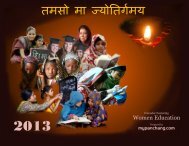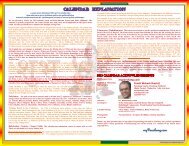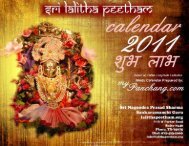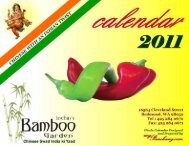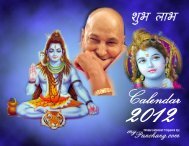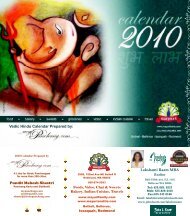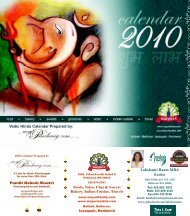12 - myPanchang.com
12 - myPanchang.com
12 - myPanchang.com
Create successful ePaper yourself
Turn your PDF publications into a flip-book with our unique Google optimized e-Paper software.
Differences in Festival dates between India and Canada<br />
The Indian Calendar/Panchangam is used everywhere where Hindu people live. I even see people<br />
posting, “ I want pambu Panchangam, but I live in the USA and it is not available”. The question then<br />
arises: “Can Indian Panchangam be used outside of India?”.<br />
People usually align the Hindu festivals with the English dates based on the Indian calendar. They<br />
then think that if an Indian calendar says “Janmasthami” on a certain date, say September 2 nd 2010,<br />
then it will appear as September 2 nd everywhere in the world. The USA is 10:30 to 15:30 hours<br />
behind India, so some people will think it will also <strong>com</strong>e the next day in the USA, i.e. September 3 rd<br />
2010. They also argue that their family priest in India has told them to celebrate on this particular<br />
date and according to him the Indian calendar will apply to all places in the world. This is a<br />
<strong>com</strong>pletely wrong assumption.<br />
The English date and day (Sunday, Monday, Tuesday etc..) changes at midnight; whereas the Hindu<br />
date (or Tithi) and day does not change at midnight. Hindu days change at Sunrise. All days are from<br />
one Sunrise to another Sunrise. Sunday will start at one Sunrise and end at the next Sunrise.<br />
The Hindu date (or Tithi -- depending on the position of the Sun and Moon at any given time)<br />
changes as celestial bodies move. It can change anytime between two Sunrises. That is to say that if<br />
Prathama Tithi ends today at 23:02 it does not mean that Dwitiya Tithi will end tomorrow at the<br />
same time. It can end at 18:00, 18:09 or 28:27 (anytime after 24 means after midnight but before the<br />
next Sunrise).<br />
Now what's the Hindu date (Tithi)?<br />
It is simple. A Tithi is a lunar day, or the time it takes for the longitudinal angle between the Sun and<br />
the Moon to increase by <strong>12</strong>°. Tithis begin at varying times of day and vary in duration from<br />
approximately 19 to 26 hours. So the maximum distance between the Sun and the Moon can be 360<br />
degrees. If you divide them by <strong>12</strong> degrees that gives you 30 equal parts. This means that we have 30<br />
dates in the Hindu calendar divided between the bright half (Shukla Paksha, Waxing Moon), and the<br />
dark half (Krishna Paksha, Waning Moon).<br />
Panchangam contains two types of calculations. One is based on the local coordinates like longitude<br />
and latitude (Sunrise, Sunset, Moonrise, Moonset, etc), and the other is based on geocentric<br />
planetary positions.<br />
Sunrise, Sunset, Moonrise, Moonset times are always calculated for each and every place on the<br />
Earth. Local Sunrise, Sunsets are used to find the daily Rahukalam, Yamagandam, Gulikai, and<br />
Durmuhurtham times.<br />
The other set of calculations are calculated from the center of the Earth (geocentric). The positions<br />
of heavenly bodies are calculated from the center of the Earth and hence they are geocentric. The<br />
planetary positions are first calculated from the center of the Sun (heliocentric) and then using the<br />
spherical trigonometry they are converted to the center of the Earth (geocentric). The Tithi,<br />
Nakshatra, Yoga, Karana and daily planetary positions are based on the positions of the Sun and<br />
Moon in the heavens and they are part of the astronomical phenomenon. These are astronomical<br />
phenomenon which happen instantly at the same moment on Earth, and hence the Tithi and<br />
Nakshatra will end at the same time all over the world. We have to, therefore, convert them to the<br />
local standard time of the specific country of interest. When an eclipse occurs and is visible all over<br />
the world, the time of occurrence is converted into each country’s local time zone. The planets do<br />
not wait for Sunrise or Sunset at the particular place. They just keep moving, like Earth is moving<br />
around the Sun.<br />
These planetary positions of the Sun and the Moon are <strong>com</strong>puted based on the local time (longitude,<br />
latitude) converted to the Universal Time. The Tithi end time is also calculated in the Universal Time<br />
which is then converted to the local time of the place. The planets are calculated from the center of<br />
Pundit Mahesh Shastriji<br />
Panchang Ganitha and Siddhanta<br />
mypanchang.<strong>com</strong>, seattlepandit.<strong>com</strong><br />
the Earth and their positions at the given time will be the same all over the world. In the same way,<br />
whenever any celestial event occurs we need to convert it to our local time zone. Indian Panchang<br />
makers convert this to Indian time. The same say we need to convert it to our time zone for America<br />
(PST/PDT, CST/CDT, MST/MDT, EST/EDT). After adding the time difference we get the resulting<br />
English date and time when they end. Hence, when the calendar is made for India the date they<br />
mention is when that Tithi will end as per the English date in India. If we take the same date and<br />
time use it anywhere in the world as it is then we will have wrong results.<br />
For example:<br />
On October 17th 2008 the Ashwayuja (Ashwin) Krishna Paksha/ Poornimant Kartik Krishna Paksha<br />
Tithi Tritiya ends at 16:39:21 Indian Standard Time, and Charturthi starts. That means at 16:00 hours<br />
there is Tritiya still prevailing in India. Now on October 17th 2008 in Vancouver, WA at the 16:00<br />
hours we won't have Tritiya at that time. We already have Chaturthi started. Planets keep on<br />
moving.... 13 hours have passed and the position of Sun and Moon have changed. So what time will<br />
Tritiya end in Vancouver? The time difference is 13 hours 30 minutes (with one of our Daylight<br />
Saving Time it gives the difference of <strong>12</strong> hours 30 minutes from IST). So, let's subtract <strong>12</strong> hours 30<br />
minutes from the 16:39:21. That gives us 04:09:21 AM on October 17th. So on October 17th after<br />
that time we'll have Chaturthi Tithi and before we have Tritiya. The same way if Tithi ends at 8:39<br />
AM on Septemer <strong>12</strong> in India it will end at 20:09 PM on September 11th in Vancouver. The same way<br />
Western Australia is 8 hours ahead of GMT and hence the Chaturthi will end there at <strong>12</strong>:09 PM on<br />
September <strong>12</strong>th. The planets do not wait for the appropriate Tithi to arrive on some English date at<br />
any location in the world. If it did we would not have any days and nights (if it were to happen then<br />
celestial bodies would remain static in sky). The Earth is round and it keeps moving, so we have days<br />
and nights. It does not wait for Tithi or festivals. Time never waits for anyone. It goes on. The Sun<br />
does not rise instantly at the same time all over the world. Hence we need to convert the Tithi,<br />
Nakshatra, Yoga, and Karana time to local standard time. Now we know what time a given Tithi ends,<br />
so now it is time to decide festival dates for each region.<br />
How festivals are determined?<br />
The usual rule to observe a festival for a particular day, check which Tithi prevails at that Sunrise.<br />
Each festival has different rules of observance. For example: Ganesh Chaturthi. Sankathara<br />
(Sankshathi Chauth) Chaturthi, Janmashtami, Mahashivaratri, Karwa Chauth, etc... For example<br />
Ganesha Chaturthi has to be oserved when the Chaturthi Tithi is observed during the 8th/15th part<br />
of the dinmana or the 3/5th part of the dinmana. The dinmana is the difference between local<br />
Sunset and Sunrise on the same day. If Chaturthi is not prevailing during that period then take the<br />
second day. Likewise for the Karwa Chauth and the Sankathara Chaturthi the Chaturthi Tithi must be<br />
prevailing during the moonrise time, if it does not prevail then take the day where it prevails during<br />
the sunrise. Rules to determine Shraddha Tithi are different.<br />
For example, if one Tithi is observed at moonrise in India it may or may not exist during moonrise on<br />
the same day in a different part of the world. It may be very well observed on the previous day if you<br />
are in America or the next day if you are in Japan, Fiji, Australia and other countries. America is<br />
behind India in terms of time. To arrive at the time in India we need to subtract the time from Indian<br />
time and hence festivals could arrive a day early in USA but not later. For example if a total lunar<br />
eclipse is visible in India at 5:00 AM it will happen on the previous day in the USA.<br />
For these reasons Indian Panchangam you buy in India cannot be used outside of India.<br />
Nanda Jewellers Inc.<br />
Panchanga Calculations by mypanchang.<strong>com</strong>





